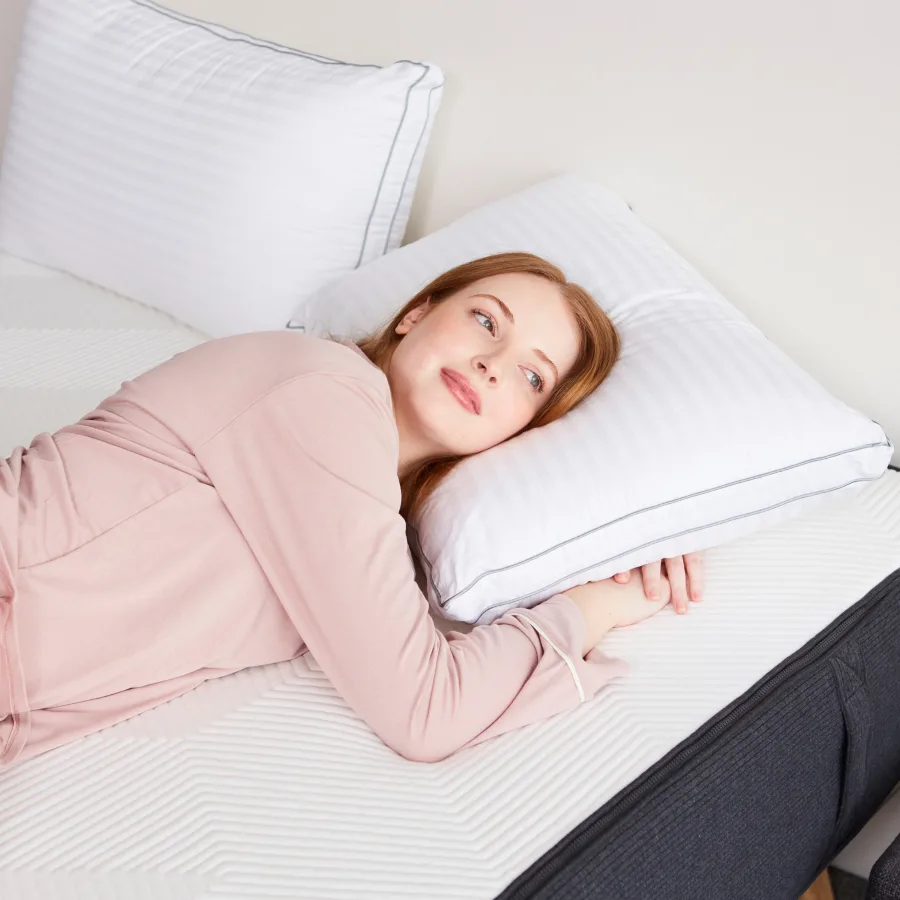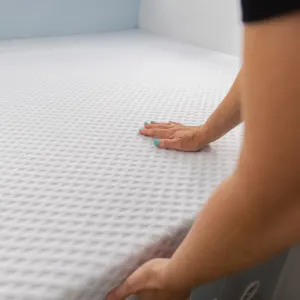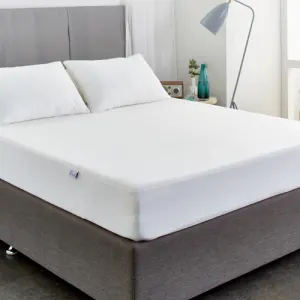The Importance of Replacing Your Pillow: Signs It's Time for a New One
By Clark Rubber | 19th February, 2025
A good night's sleep is essential for our well-being, and one of the key elements in achieving this is choosing the right pillow. Did you know…30% of our sleep comfort is influenced by the support provided to our head? This is because, out of the 24 articulated vertebrae in the spine, 7 are located in the neck. So, even with the most expensive mattress, if we are sleeping on an inadequate or improperly fitted pillow, nearly one-third of our vertebrae lack the necessary support, potentially causing discomfort and poor sleep quality.
Why Refreshing Your Pillow Matters
Over time, pillows lose their supportive qualities, accumulate dust mites, bacteria, and allergens, and their structure begins to break down, leading to less effective support and poor sleep quality. A pillow that’s past its prime can lead to neck and back pain, poor posture, and even affect your breathing while you sleep. By replacing your pillow every two years, you ensure that your sleep is comfortable and restorative, providing the right support for your body.
Five Signs It's Time for a New Pillow:
1. The Fold Test: A Simple Way to Check If Your Pillow Needs Replacing
Not sure if your pillow is still providing the support you need? Try this quick and easy pillow test:
- Place your pillow on a flat surface and fold it in half.
- Hold it down for 30 seconds to a minute.
- Let go and observe what happens.
If your pillow bounces back into shape, it’s still in good condition. If it stays folded, it has lost its support and should be replaced.
Experts recommend testing your pillow every six months to ensure it continues to provide proper neck and spine support.
2. How Long Does a Pillow Last? Understanding Pillow Lifespan
Different pillow materials wear out at different rates. If you’re unsure whether your pillow is still effective, check the lifespan of its filling:
- Memory foam & latex: 5–10 years
- Feather & down: 5–10 years
- Cotton & wool: 3–5 years
- Polyester: 6 months to 2 years
If your pillow feels lumpy, flat, or uncomfortable, it may be time for a new one. Choosing high-quality materials can extend your pillow’s lifespan and improve sleep quality.
3. Does Your Pillow Have an Expiration Date?
Some manufacturers, include a stamped use-by date on their pillows, typically recommending replacement every two years.
Although this may seem like a marketing strategy, pillows do collect a significant amount of dust, sweat, and allergens over time. Experts generally suggest replacing pillows every two to three years to maintain hygiene and sleep quality.
If your pillow does not have a printed expiration date, pay attention to changes in shape, firmness, and overall comfort to determine when it needs replacing.
4. Waking Up with Neck Pain? Your Pillow Could Be the Cause
If you wake up with neck stiffness or shoulder pain, your pillow may no longer be providing proper support.
A good pillow should:
- Keep your head, neck, and spine in a neutral position
- Provide adequate support based on your sleeping position
- Maintain its shape and firmness over time
If you find yourself folding your pillow in half or stacking multiple pillows for comfort, it may be time to invest in a new one.
5. A Misshapen Pillow Can Disrupt Your Sleep
Over time, pillows lose their shape and firmness, affecting sleep quality and spinal alignment. If your pillow is lumpy, sagging, or no longer fluffs back up, it has likely outlived its usefulness.
No amount of fluffing or adjusting will restore its original support. Upgrading to a new pillow can help improve sleep posture and overall comfort.
Sleeping Positions and Pillow Support
The right pillow can significantly impact your sleep quality, depending on your preferred sleep position. There are three primary sleeping positions: stomach, back, and side. Each position requires different types of pillow support to ensure spinal alignment and comfort.
Stomach Sleepers: If you sleep on your stomach, it’s important to choose a low-profile pillow to prevent your head from being pushed too high, which can strain your neck and spine. A softer, thinner pillow allows for proper alignment and can reduce discomfort.
Back Sleepers: For back sleepers, a medium-profile pillow is ideal to maintain the natural curve of your neck and avoid unnecessary pressure on the spine. The pillow should support the head without pushing it too far forward.
Side Sleepers: Side sleepers typically need a thicker, firmer pillow to fill the gap between the neck and shoulder, maintaining spinal alignment. A pillow that offers good support for the head, neck, and upper body is essential to avoid stiffness or discomfort in the morning.
Key Pillow Options for Comfort and Support
The following range of pillows cater to various sleep preferences and needs:
Foam Core Pillow with Polyester Fibre Surround and Cotton Sateen Cover
This type of pillow offers a combination of firmness and softness, making it suitable for a variety of sleep positions. The foam core provides solid support for the head and neck, while the polyester fibre surround adds a soft, plush feel. The cotton sateen cover gives the pillow a luxurious, smooth texture that is gentle on the skin. Ideal for back and side sleepers, this pillow helps maintain proper spinal alignment.
Benefits:
- Balanced support with foam core and softness of polyester fibres
- Luxurious cotton cover for a smooth, gentle feel on skin
- Excellent for back and side sleepers

Dreemi Foam Core Gusseted Pillow
Copper Infused Memory Foam Pillow
Copper-infused memory foam pillows are popular due to their combination of comfort and health benefits. The memory foam adapts to the shape of your head and neck, providing customised support. The copper infusion offers antimicrobial properties, helping to keep the pillow clean and fresh by reducing bacteria and dust mites. This pillow is excellent for side sleepers, as the memory foam cradles the head and neck, ensuring proper alignment.
Benefits:
- Antimicrobial properties for a cleaner sleep environment
- Pressure-relieving memory foam that adapts to your neck and head
- Ideal for side sleepers with neck support needs

Dreemi Copper Memory Foam Pillow
Polyester Fibre Pillow with Microfibre Cover
For those seeking an affordable, lightweight option, a polyester fibre pillow with a microfibre cover can offer comfort and softness without compromising on support. The polyester filling is resilient and maintains its shape, while the microfibre cover feels soft and smooth. This type of pillow works well for stomach sleepers or those who prefer a softer, lower pillow profile. It’s also a great hypoallergenic option for those sensitive to dust or allergens.
Benefits:
- Lightweight and affordable
- Soft, breathable microfibre cover
- Hypoallergenic and gentle on sensitive skin
- Ideal for stomach sleepers

Comfort Rolled Polyester Pillow
Shredded Memory Foam Pillow with Stretch Knit Cover [Comfort Shredded Memory Foam Pillow]
The shredded foam offers great support for back and side sleepers, as it moulds to your head and neck while maintaining proper alignment. The stretch knit cover is soft and breathable, allowing for optimal airflow to keep the pillow cool throughout the night.
Benefits:
- Breathable stretch-knit cover for a cool sleep
- Durable and resilient
- Supports a variety of sleep positions, especially back and side sleepers

Comfort Shredded Memory Foam Pillow
Choosing the Right Pillow for Your Sleep Needs
When it comes to selecting the best pillow, it's essential to consider your sleeping position, preferences, and any specific health concerns (like allergies or neck pain). A new pillow can offer significant improvements in sleep quality, comfort, and overall health. Whether you’re looking for antimicrobial properties, foam support, or a soft, plush feel, we have a pillow option that fits your needs. Don't wait for your pillow to lose its shape or support—refreshing it every two years is a simple yet effective way to ensure you're getting the best possible rest. A good pillow is an investment in your health and well-being. Find the right pillow for you today!













